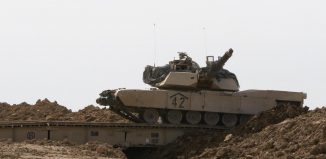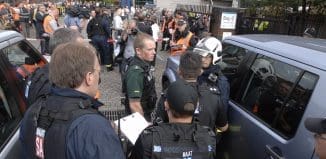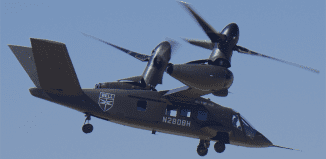INSS: The Future of Unmanned Systems
This post is also available in:  עברית (Hebrew)
עברית (Hebrew)
 Israeli policy makers may still be unaware of the future strategic potential of the widespread use of unmanned systems. The state may be missing the point, which is to look at unmanned systems as a tool with which strategic goals can be achieved. The state must establish a general unmanned systems authority, its members responsible for forming a long term development plan.
Israeli policy makers may still be unaware of the future strategic potential of the widespread use of unmanned systems. The state may be missing the point, which is to look at unmanned systems as a tool with which strategic goals can be achieved. The state must establish a general unmanned systems authority, its members responsible for forming a long term development plan.
These are some of the main conclusions of the research paper “Unmanned Systems in Defense 2035, From Technological Predictions to Policy”. The research was conducted by staff at the Institute for National Security Studies, in cooperation with the “Tsofen Atid” company and the Tel Aviv University Technological and Social Prediction Unit. The research’s demonstration plan was recently presented at an INSS convention held in Ramat Aviv. The researchers used special questionnaires focusing on the future of unmanned systems, given to more than 300 local and international experts. A 30-member team of researchers analyzed the data and formed the research conclusions and recommendations.
In his opening address Brig. Gen. (Res.) Uzi Eilam, senior INSS researcher, said that after the Yom Kippur War of 1973, when he served as the head of the Defense Ministry R&D division, he proposed the development of unmanned systems to achieve “over the hill” intelligence gathering capabilities in the field. His proposal was denied. When it was presented to IAI the answer was “We don’t deal with toys, we develop aircraft”. “Today”, added Eilam, “things are different.”
Yoav Zachs, director of the technological and policy prediction program at the institute, explained that the research focused on the next 20 years. The questions are what will the unmanned systems’ artificial intelligence be capable of, and how should Israel prepare itself for an age of unmanned systems used extensively by armies and civilians.
Research director Liran Antabi said: “Robots are not the future – they’re the present.” A robot is exploring Mars; the U.S. is developing a stealth UAV for the Air Force and CIA; Amazon promises shipment by UAV to clients; and Boston Dynamics developed a robot that can climb stairs, sit down, stand and act like a living being.
Robots, according to Antabi, are man-made machines with three key features: Feel, think and act. There are four degrees of autonomous activity: A system controlled by a human operator, a system directed by a human operator, a system supervised a human operator, and a fully autonomous system. Antebi added that in 2012 the Americans possessed 8,000 unmanned systems, a third of the air force, and 12,000 ground systems. According to the research 2026-2035 will see more unmanned missions than manned, while in 2013 70 countries already have operational unmanned systems. Antabi said, however, that there still are psychological problems – a difficulty to integrate and distrust of non-human systems. There are also moral-legal problems having to do with the use of attack UAVs. “Various organizations vehemently oppose machines with the power of death and life over humans. The Pentagon specifically ordered that only humans will decide when robots will kill.”
An important issue is the use of unmanned systems by terrorist organizations, and defending against this type of attacks. Antebi said that there have been real attempts to infiltrate Israel by unmanned systems, while Hezbollah prevented a terror attack which was to be carried out by UAV. According to Antebi Israel is currnely largest UAV exporter.
Dr. Aharon Hauftman and Dr. Roy Tzezna from Tel Aviv University reviewed the researchers’ predictions on unmanned systems 20 years from now:
- A significant improvement in response times of single systems or swarms
- A significant improvement in the reliability of systems, leading to increased trust by humans
- Improved frind-or-foe capabilities, assessing damage and automatic IED detection
- The capability to identify a person in an urban environment from a range of 200 meters
- Improved self learning and intelligence gathering capabilities
- Significant boosts to endurance – up to 10 additional hours for large vehicles, 80 hours for medium and 50 hours for small
- Integrated cyber-attack capabilities. Improved defenses against cyber-attacks.
IHLS – Israel Homeland Security
20 years from now, according to the research, robots will be entirely different:
- Robots with biological components
- Transforming robots – systems that could, for example, shrink in order to enter a blocked building through small openings, then expand again. Soft robots
- A perfectly camouflaged robot, invisible to human eyes while in the air
- A self replicating robot
Dr. Noa Agmon from the Bar Ilan University Computer Science Department presented swarms – unmanned systems operated in groups. A swarm is a non-intelligent group of robots, with simple communications capabilities and low processing power. Groups of unmanned systems included a smaller number of 20-30 intelligent systems for complex missions, with interaction capabilities and the ability to command less complex robots.
The researchers came to the conclusion that 20 years from now there will be autonomous systems capable of tactical planing on almost every level of military command. Some systems will be operated by autonomous swarms. The military campaign itself will be different, including the concept of resolving the battle. No more physical destruction of enemy forces – victory will mean disruption of communications between units, or immobilizing units.
Prof. David Psig from Bar Ilan University: The research team assumed that Israel isn’t properly utilizing its unmanned capabilities. The recommendation is that decision makers define and enact a comprehensive, general policy on the use of unmanned systems, and new think tanks should be established in order to do so in a methodical, organized fashion. Unmanned systems, said Psig, will change IDF operational procedures, and therefore the defense establishment must prepare, define priorities and budgets, train highly skilled personnel and form procedures for defense against unmanned systems.
Maj. Gen. (Res.) Dan Halutz presented a different, more gradual and evolutionary approach to unmanned systems: Unmanned systems are developing rapidly, but they have to also develop gradually, while integrating manned and unmanned systems. Halutz admitted: “There could have been greater achievements in the field, but many decision makers are too conservative.” Halutz differentiates between three main areas:
- Unmanned systems for planning, command and control. “But a human has to sit at the helm, and combine all the information in order to reach a decision”
- Unmanned intelligence systems, target acquisition
- Multipurpose unmanned weapon systems for land, air and sea, to operate alongside manned weapon systems
Halutz predicts an evolution, not a revolution: “We’re in the top five countries in the unmanned systems field, and number one in several subsections of that field. It’s a quality revolution. Flight computers can already calculate optimal flight paths for the human pilots. The Heron UAV can remain airborne for 24 hours, while three to six manned airplanes are needed to maintain the same coverage. The era of manned aircraft, however, isn’t over yet, and it won’t be over in 20 years, if only for psychological reasons. I don’t think anyone will agree to board an unmanned passenger plane, for example. Unmanned systems won’t replace manned systems in the near future. The key is combining the two.”
Dan Halutz, who is a former Air Force Commander, concluded: “In the end human beings will raise victory flags, not robots.”






























